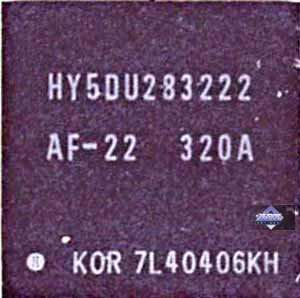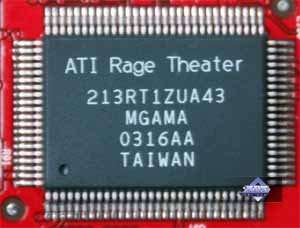GeCube RADEON X600XT Extreme based on ATI RADEON X600 XT
|
Contents
- Video card's features
- Testbed configurations, benchmarks, 2D quality
- Test results: Serious Sam: The Second Encounter
- Test results: Unreal Tournament 2003
- Test results: Unreal II: The Awakening
- Test results: RightMark 3D
- Test results: TRAOD
- Test results: FarCry
- Test results: Call Of Duty
- Test results: HALO: Combat Evolved
- Test results: Half-Life2(beta)
- Test results: Splinter Cell
- Test results: Return to Castle Wolfenstein
- Test results: DOOM III
- Conclusions
In spite of the fact that there appeared newer solutions based on PCI-E interface, manufacturers of video cards based on firstlings in this segment, in particular RADEON X600, are seeking any methods to attract customers to their products.
The same with GeCube, which already became famous for its stronger (that is overclocked) modifications of accelerators. We already reviewed such a card based on RADEON 9550. By the way, here is a complete list of articles devoted to the ATI technologies, which are implemented in a series of cards of several generations.
Theoretical materials and reviews of video cards, which concern functional properties of the GPU ATI RADEON 9500/9600/9700/9800 (R300-R350)
- Analysis of RADEON 9700
architecture and Microsoft DirectX 9.0
- ATI RADEON 9700 Pro
128MB Review
- Gigabyte MAYA II
R9700Pro 128MB - performance estimated on the new Pentium 4
2.53 GHz based platform, comparison with the NVIDIA's 40.41 driver
- Hercules 3D Prophet
9700 Pro 128MB - new CATALYST 2.3 driver estimated in 3DMark2001
SE, and Unreal Tournament 2003 DEMO final release
- PowerColor Evil Commando2 RADEON 9700 Pro 128MB
- performance of the new CATALYST 2.3 driver estimated in game tests,
3D quality issues
- Hercules 3D Prophet
9700 Pro on ATI RADEON 9700 Pro: extreme overclocking
- ATI RADEON 9500, 9700
and Gigabyte MAYA II RADEON 9500
- Sapphire Atlantis
RADEON 9500 128MB and videocards tests in DOOM III v.0.02
- ATI RADEON 9500 PRO
128MB
- Gigabyte MAYA
II RADEON 9500 PRO and Hercules 3D Prophet 9500 PRO - detailed
analysis of anisotropic filtering of RADEON 9700
- Sapphire Technology
RADEON 7500, 8500, 9000/Pro, 9700 Pro, anisotropic filtering
of RADEON 9700
- HIS Excalibur RADEON
9700 PRO - Tests in DirectX 9.0 RC0
- ATI RADEON
9500 64MB, 9500 128MB, 9500 PRO, 9700 and 9700 PRO in DirectX 9.0:
Part 1 - Game tests in 3DMark2001, and Soft9700!
- ATI RADEON
9500 64MB, 9500 128MB, 9500 PRO, 9700 and 9700 PRO in DirectX 9.0:
Part 2 - Tests in DirectX 9.0 - synthetic tests from RightMark 3D
- Sapphire
Atlantis RADEON 9700 and RADEON 9700 PRO Ultimate Edition
- YUAN SmartVGA RADEON
9000 64MB and RADEON 9700 PRO
- Connect3D video
cards on the ATI's chips
- ATI RADEON 9800 PRO
128MB
- ATI RADEON 9600 PRO 128MB: Part 1 - game
tests and performance
- Hercules 3D Prophet 9800 PRO 128MB
and Hercules 3D Prophet 7500 128MB, and scandal around the 3DMark03
- Hercules 3D Prophet 9800 PRO 128MB
and Hercules 3D Prophet 7500 128MB (single page)
- Sapphire Technologies ATI RADEON 9200/9600/9600PRO/9800PRO
video cards
- Connect3D, Gigabyte and CP.Technology
ATI RADEON 9800 PRO video cards
- Sapphire Atlantis RADEON 9600 256MB, Sapphire
Atlantis RADEON 9600 PRO Ultimate Edition 128MB, Gigabyte RADEON
9600 PRO 128MB, Hercules 3D Prophet 9600 PRO 128MB
- Sapphire Atlantis RADEON 9200 PCI 64MB
64bit, Sapphire Atlantis RADEON 9200SE 128MB, Sapphire Atlantis
RADEON 9800SE 128MB 128bit, Sapphire Atlantis RADEON 9800 128MB,
Sapphire Atlantis RADEON 9800 PRO Lite 128MB, PowerColor RADEON
9800SE 128MB 256bit
- ATI RADEON 9800 XT 256MB
- TYAN TACHYON G9800Pro-M 128MB on ATI
RADEON 9800 PRO
- ASUSTeK ATI RADEON 9200SE/9600SE/9600XT/9800XT
cards
- Sapphire Atlantis RADEON 9800XT 256MB
and RADEON 9800SE 128bit
- Connect3D RADEON 9800 XT 256MB 256
- ATI RADEON 9800 XT: extremal overclocking
- Voltmodding RADEON 9800 XT - Part 1
- HIS Excalibur RADEON X600XT Limited Edition
VIVO
Today, when GeForce 6600/6600GT, RADEON X700/X700PRO/X700XT are already released, it seems uninteresting and even strange to review X600XT. But, nevertheless, X600XT cards are still in production, they will just gradually be reduced in price and move to a cheaper sector.
This product is interesting because it offers users higher speed than its competitors for approximately the same price as regular X600XT.
Let's give it a closer look.
Video card
| GeCube RADEON X600XT Extreme |

|
| GeCube RADEON X600XT Extreme |
| The card has the PCI-Express 16x interface, 128 MB
DDR SDRAM allocated in 8 chips on the front and the back sides
of the PCB.
Hynix memory chips. 2.2ns memory access time, which corresponds
to 450 (900) MHz. Memory operates at 400 (800) MHz. GPU frequency
— 540 MHz. 128-bit memory bus. 4 pixel pipelines and 2
vertex ones. Pay attention to the increased memory and chip
operating frequencies instead of normal 500/380 (760) MHz.
|

|
| Comparison with the reference design,
front view |
| GeCube RADEON X600XT Extreme |
Reference card ATI RADEON X600XT |

|

|

|
| Comparison with the reference design,
back view |
| GeCube RADEON X600XT Extreme |
Reference card ATI RADEON X600XT |

|

|
This card is obviously based on the reference design. The only difference is that the video card from GeCube is equipped with the RAGE Theater codec to provide VIVO:
And of course, faster memory chips that make this card very attractive to overclockers. What concerns increased operating frequencies of the memory and the chip, an unusual cooler construction comes to the rescue.
| GeCube RADEON X600XT Extreme |
|
The design is obviously styled after the famous cooling system
from RADEON 9800 XT. As I have already mentioned, such a cooler
is necessary because the core is well overclocked, and the memory
is faster and features higher thermal emission. That's why there
is another plate in the back to cool memory chips allocated
on the back of the PCB.
|

|

|
Interestingly, we have already come across markings on X600XT processors clearly stating that. And here we can see only codes.
Let's have a look at the package contents.
| GeCube RADEON X600XT Extreme |
|
The box contains a user's guide, CD with drivers, PowerDVD,
VIVO software, Counter-Strike: CZ; TV extension cords, DVI-to-d-Sub
and SVideo-to-RCA adapters.
|

|
And now, let's have a look at the box itself:
| GeCube RADEON X600XT Extreme |
|
The box is designed with taste! Very bright and attractive.
Everything is arranged in sections inside.
|

|
Installation and Drivers
Testbed configurations:
-
Pentium4 Overclocked 3200 MHz (Prescott) based computer
- Intel Pentium4 3600 MHz CPU (225MHz x 16; L2=1024K, LGA775); Hyper-Threading enabled
- ABIT AA8 DuraMAX mainboard based on i925X
- 1 GB DDR2 SDRAM 300MHz
- WD Caviar SE WD1600JD 160GB SATA HDD
- Operating system – Windows XP SP2; DirectX 9.0c
- Monitors: ViewSonic P810 (21") and Mitsubishi Diamond Pro 2070sb (21").
- ATI drivers v6.476 (CATALYST 4.9); NVIDIA drivers v65.76.
VSync is disabled.
It should be noted that both companies have enabled trilinear filtering optimizations in their drivers by default.
Test results
Before giving a brief evaluation of 2D, I will repeat that at present there is NO valid method for objective evaluation of this parameter due to the following reasons:
- 2D quality in most modern 3D accelerators dramatically depends on a specific sample, and it's impossible to evaluate all the cards.
- 2D quality depends not only on the video card, but also on the monitor and a cable.
- A great impact on this parameter has been recently demonstrated by monitor-card combos, that is there are monitors, which just won't "work" with specific video cards.
What concerns the combo of our sample under review and Mitsubishi
Diamond Pro 2070sb, this card demonstrated the excellent
quality in the following resolutions and frequencies:
| GeCube RADEON X600XT Extreme |
1600x1200x75Hz, 1280x1024x120Hz, 1024x768x160Hz
|
Test results: performance comparison
We used the following test applications:
- Serious Sam: The Second Encounter v.1.05 (Croteam/GodGames) – OpenGL, multitexturing, ixbt0703-demo, test settings: quality, S3TC OFF
- Unreal Tournament 2003 v.2225 (Digital Extreme/Epic Games) – Direct3D, Vertex Shaders, Hardware T&L, Dot3, cube texturing, default quality
- Unreal II: The Awakening (Legend Ent./Epic Games) – Direct3D, Vertex Shaders, Hardware T&L, Dot3, cube texturing, default quality
- RightMark 3D v.0.4 (one of game scenes) – DirectX 8.1, Dot3, cube texturing, shadow buffers, vertex and pixel shaders (1.1, 1.4).
- Tomb Raider: Angel of Darkness v.49 (Core Design/Eldos Software) – DirectX 9.0, Paris5_4 demo. The tests were conducted with the quality set to maximum, only Depth of Fields PS20 was disabled.
- HALO: Combat Evolved (Microsoft) – Direct3D, Vertex/Pixel Shaders 1.1/2.0, Hardware T&L, maximum quality
- Half-Life2 (Valve/Sierra) – DirectX 9.0, demo (ixbt07. The tests were carried out with enabled anisotropic filtering as well as in heavy mode with AA and anisotropy.
- Tom Clancy's Splinter Cell v.1.2b (UbiSoft) – Direct3D, Vertex/Pixel Shaders 1.1/2.0, Hardware T&L, Very High settings; demo 1_1_2_Tbilisi
- Call of Duty (MultiPlayer) (Infinity Ward/Activision) – OpenGL, multitexturing, ixbt0104demo, test settings – maximum, S3TC ON
- FarCry 1.2 (Crytek/UbiSoft), DirectX 9.0, multitexturing, demo01 (research) (the game was started with the -DEVMODE option), test settings – Very High.
- Return to Castle Wolfenstein (MultiPlayer) (id Software/Activision) – OpenGL, multitexturing, ixbt0703-demo, test settings – all to maximum, S3TC OFF,
- DOOM III (id Software/Activision) – OpenGL, multitexturing, test settings – High Quality (ANIS8x),
If you want to get the demo-benchmarks, which we use, contact me at my e-mail.
In the diagrams with the ANIS16x (AA4x+ANIS16x) caption the video card based on GeForce FX 5950 Ultra was tested in the ANIS8x (Quality) mode, the other cards – ANIS16x (Quality)
Conclusions
It's crystal clear that in some tests the new video card outscores even GeForce 6600 in modes with AA due to its fairly good memory bandwidth (relatively!). Very often the product from GeCube outscores a monster of a card PCX5900.
But on the whole, you can see that no matter what you do with the 4-pipeline chip, it can hardly compete with equally priced 8-pipeline chips, even if the frequency difference reaches the twofold mark. In fact, only its chip operating at 540 MHz somehow helps X600XT Extreme to stay up.
This video card is very good and may be in demand as long as its price is lower than that for GeForce 6600. I understand, it's very hard to achieve due to 2.2ns memory and more expensive PCB than in 6600. But if they want to get 150-180 USD for this card, they should understand that one can get a faster video card for this price. That's why I hope that the price for video cards like GeCube RADEON X600XT Extreme will quickly drop to $130 or even lower, and then their success will be guaranteed.
In our 3Digest you can find more detailed comparisons of various video cards.
According to the test results, GeCube RADEON X600XT Extreme gets the Original Design award (October).
Write a comment below. No registration needed!
|
|
 |
|
|
|











